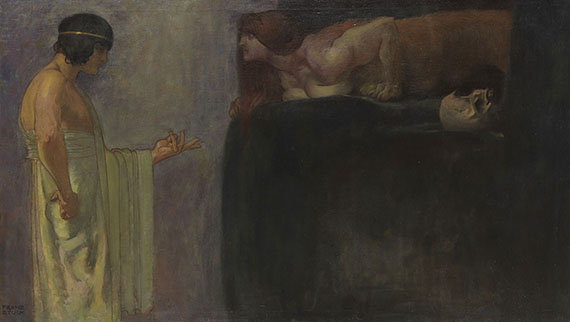Dictionary


Dutch Symbolism
Symbolism was not widely spread in the Northern Netherlands, quite unlike Belgium. Just as its southern neighbor, Holland experienced an economic and cultural boom in the second half of the 19th century. In art, Realism was the prefered tendency, as it already had a long tradition and was represented by the School of Hague. The parallel bloom of these oppositional concepts of art in the two countries that were so much alike in general, gives reason to raise the question regarding the relevant causes thereof. The Dutch preference for Realism can be ascribed to the pragmatic attitude of the Protestants. Unlike Symbolism's fantastic world, its tendency to idealize and the rejection of reality, which was so succesful in the Catholic Belgium.
But yet, there were two successful Dutch symbolists, which were in close connection with the French movement. First of all, Jan Toorop (1858-1928) is worthwhile mentioning. The works of the Java native, which can be ascrbed to Symbolism as of 1891, are characterized by the artists elegant usage of bent and fluctuating lines and the stylized figure that calls reminiscence of the Java galanty show figures with their slim and elongated limbs. Toorop prefered to depict religious topics and confessed to Catholicism in 1905. Theosophy, which was quite popular among symbolists, played an imporrtnat role in the conception of his works, which in return were sources of inspiration for Art Nouveau.
In terms of a formal perspective, Johan Thorn Prikker (1868-1932) went a step further than Toorop. The intrinsic value of the line attained an almost autonomous character in his works, the motifs depicted, such as in his painting "Die Braut" (The Bride, 1892-93), are harder to recognize. Thus the artist went a path that would later on lead to Art Nouveau and a "spiritual" abstraction.
Symbolism was not widely spread in the Northern Netherlands, quite unlike Belgium. Just as its southern neighbor, Holland experienced an economic and cultural boom in the second half of the 19th century. In art, Realism was the prefered tendency, as it already had a long tradition and was represented by the School of Hague. The parallel bloom of these oppositional concepts of art in the two countries that were so much alike in general, gives reason to raise the question regarding the relevant causes thereof. The Dutch preference for Realism can be ascribed to the pragmatic attitude of the Protestants. Unlike Symbolism's fantastic world, its tendency to idealize and the rejection of reality, which was so succesful in the Catholic Belgium.
But yet, there were two successful Dutch symbolists, which were in close connection with the French movement. First of all, Jan Toorop (1858-1928) is worthwhile mentioning. The works of the Java native, which can be ascrbed to Symbolism as of 1891, are characterized by the artists elegant usage of bent and fluctuating lines and the stylized figure that calls reminiscence of the Java galanty show figures with their slim and elongated limbs. Toorop prefered to depict religious topics and confessed to Catholicism in 1905. Theosophy, which was quite popular among symbolists, played an imporrtnat role in the conception of his works, which in return were sources of inspiration for Art Nouveau.
In terms of a formal perspective, Johan Thorn Prikker (1868-1932) went a step further than Toorop. The intrinsic value of the line attained an almost autonomous character in his works, the motifs depicted, such as in his painting "Die Braut" (The Bride, 1892-93), are harder to recognize. Thus the artist went a path that would later on lead to Art Nouveau and a "spiritual" abstraction.
Offers
Headquarters
Joseph-Wild-Str. 18
81829 Munich
Phone: +49 89 55 244-0
Fax: +49 89 55 244-177
info@kettererkunst.de
Louisa von Saucken / Undine Schleifer
Holstenwall 5
20355 Hamburg
Phone: +49 40 37 49 61-0
Fax: +49 40 37 49 61-66
infohamburg@kettererkunst.de
Dr. Simone Wiechers / Nane Schlage
Fasanenstr. 70
10719 Berlin
Phone: +49 30 88 67 53-63
Fax: +49 30 88 67 56-43
infoberlin@kettererkunst.de
Cordula Lichtenberg
Gertrudenstraße 24-28
50667 Cologne
Phone: +49 221 510 908-15
infokoeln@kettererkunst.de
Hessen
Rhineland-Palatinate
Miriam Heß
Phone: +49 62 21 58 80-038
Fax: +49 62 21 58 80-595
infoheidelberg@kettererkunst.de
We will inform you in time.




